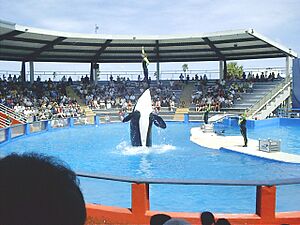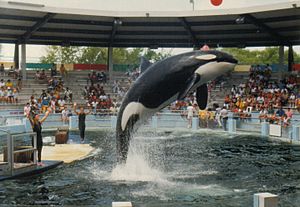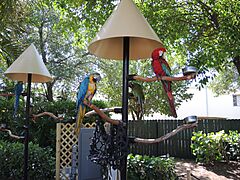Miami Seaquarium facts for kids

Main entrance.
|
|
| Date opened | September 24, 1955 |
|---|---|
| Location | Virginia Key, Miami, Florida, US |
| Land area | 38 acres (15 ha) |
| Coordinates | 25°43′59″N 80°09′56″W / 25.733°N 80.165525°W |
| Annual visitors | 500,000 |
The Miami Seaquarium is a large ocean park located on Virginia Key island in Miami, Florida. It covers about 38 acres of land. This park is home to many different marine animals.
Opened in 1955, it is one of the oldest ocean parks in the United States. Besides marine mammals like dolphins and manatees, the Seaquarium also has fish, sharks, sea turtles, birds, and reptiles. The park offers fun daily shows and special programs. These include overnight camps and events for groups. More than 500,000 people visit the Miami Seaquarium every year.
Contents
History of the Seaquarium
The Miami Seaquarium was started by Fred D. Coppock and Captain W.B. Gray. When it first opened in 1955, it was the biggest marine-life park in the world. It was only the second park of its kind in Florida.
Early Animals and TV Shows
The park's first orca was named Hugo. He was caught in 1968 and brought to the Seaquarium. Hugo lived in a small pool for two years. Over time, it became clear that Hugo did not adjust well to living in captivity. He often showed signs of distress. Hugo passed away in 1980 due to health issues.
From 1963 to 1967, many episodes of the popular TV show Flipper were filmed at the Miami Seaquarium. Two movies about Flipper were also made there. For many years, the Seaquarium also had the first hanging monorail in the United States, called the Miami Seaquarium Spacerail.
Changes in Ownership and Recent Challenges
In 2014, the Miami Seaquarium was bought by a company called Palace Entertainment. Later, in 2022, The Dolphin Company became the new owner.
In recent years, there have been concerns about the care of animals at the Seaquarium. Reports from the U.S. Department of Agriculture (USDA) in 2023 pointed out several problems. These included issues with veterinary care and how animals were handled. Miami-Dade County, which owns the land the Seaquarium is on, became worried. They considered ending the park's lease.
By early 2024, the USDA was satisfied that the park's operators had started to fix these problems. However, the Seaquarium lost its accreditation from American Humane, an organization that checks on animal welfare. The Dolphin Company also fell behind on its rent payments to the county.
In March 2024, Miami-Dade County sent a notice to The Dolphin Company. This notice said the Seaquarium's lease would end, and they had to move out by April 21. The mayor mentioned a "long and troubling history of violations." As of June 2024, The Dolphin Company was trying to fight this eviction.
In March 2025, The Dolphin Company, which owns the Miami Seaquarium, filed for Chapter 11 bankruptcy. This means they were dealing with financial challenges and debts.
Lolita the Orca

One of the most famous animals at the Miami Seaquarium was Lolita, an orca. She was also known as Tokitae. At the time of her passing in 2023, she was one of the oldest orcas living in captivity. Lolita was the last orca at the park.
Lolita was captured in 1970 in Puget Sound, Washington state. She arrived at the Miami Seaquarium in September 1970. She joined Hugo, the park's first orca. Hugo passed away in 1980.
Animal rights groups argued that Lolita's tank was too small. They said it did not meet federal rules for animal welfare. The USDA also agreed with these concerns in 2017.
Efforts to Return Lolita to the Wild
In 2014, the government considered adding Lolita to the list of endangered Southern resident orcas. These orcas live in the waters near Washington and British Columbia. Activists hoped this would help Lolita move to a sea-pen. They even hoped she might one day return to her family pod in the ocean.
The Lummi Nation, a Native American tribe from Washington State, called Lolita Sk’aliCh’elh-tenaut. They saw her as a family member, "our relative under the water." The Lummi people believed Lolita should be returned to her home waters. They often gathered at the Seaquarium to ask for her return.
In March 2023, the Miami Seaquarium announced plans to move Lolita. The idea was for her to go to a semi-wild sea-pen in the Salish Sea. This is where her family lives. Two other dolphins, Li'i and Loke, were also planned to move with her. However, Loke and her baby Elelo were moved to the Shedd Aquarium in Chicago in August 2023.
Sadly, Lolita passed away on August 18, 2023. It was believed she died from a kidney condition. After Lolita's passing, Li’i, the remaining Pacific white-sided dolphin, was moved. In September 2023, he went to SeaWorld San Antonio. There, he was reunited with other dolphins, including some family members.
Gallery
See also
- List of captive orcas
- SeaWorld Orlando









